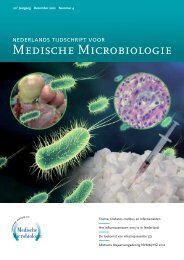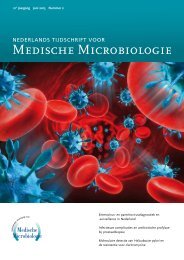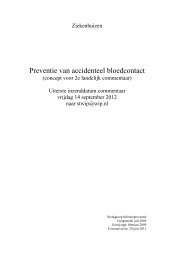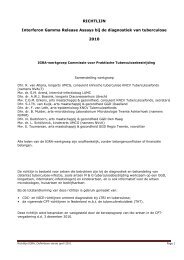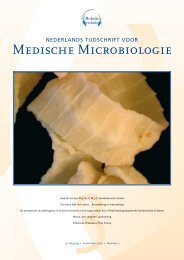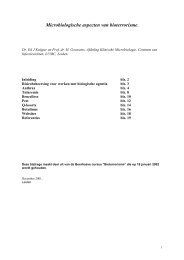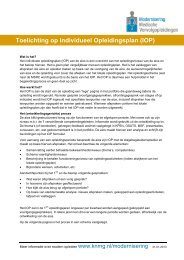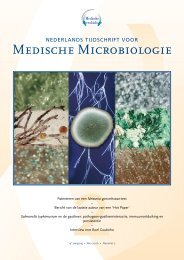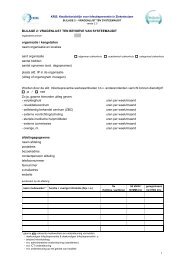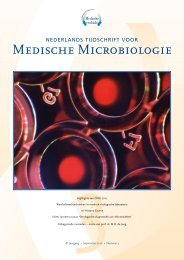S1 De voorjaarsbijeenkomst van de Nederlandse ... - NVMM
S1 De voorjaarsbijeenkomst van de Nederlandse ... - NVMM
S1 De voorjaarsbijeenkomst van de Nederlandse ... - NVMM
You also want an ePaper? Increase the reach of your titles
YUMPU automatically turns print PDFs into web optimized ePapers that Google loves.
were <strong>de</strong>termined following ISO gui<strong>de</strong>lines (ISO 20776-1)<br />
and instructions of the MICE manufacturer, respectively.<br />
For the MICE, an inoculum of 0.5 McFarland was streaked<br />
on a Mueller-Hinton agar plate. The MICE strips were put<br />
on the plate and incubated for 16-20h. The MIC values<br />
were read following instruction by two in<strong>de</strong>pen<strong>de</strong>nt lab<br />
technicians. The following MICE strips were evaluated:<br />
gentamicin 256-0.016 mg/L (Ge 256), gentamicin<br />
1024-0.064 mg/L GE024), amoxicillin 256-0.016 mg/L<br />
(AM), cefotaxime 32-0.002 mg/L (Cef32), cefotaxime<br />
256-0.016 mg/L (Cef256), levofloxacin 32-0.002 mg/L (LE),<br />
imipenem 32-0.002 mg/L (IM), ciprofloxacin 32-0.002<br />
mg/L (CI), amoxicillin/clavulanic acid 256 – 0.016 mg/L<br />
(AC). For the interpretation of the MIC and MICE the<br />
EUCAST breakpoints were used. Discrepancy analysis was<br />
performed following the ISO gui<strong>de</strong>line.<br />
Results: The isolates collected belonged to the following<br />
species Citrobacter species (n=15), Enterobacter spp (n=35),<br />
Escherichia coli (n=80), Hafnia alveii (n=1), Klebsiella spp<br />
(n=84), Morganella morganii (n=10), Pantoea agglomerans<br />
(n=1), Proteus species (n=67), Provi<strong>de</strong>ncia rettgeri (n=1),<br />
Serratia marcescens (n=6). 63% of the strains were<br />
susceptible for the different antimicrobial agents. The<br />
category agreement after discrepancy analysis was:<br />
GE256 99%, GE1024 99%, AM 96%, cef32 99%, cef256<br />
99%, LE 98%, IM 99%, CI 98%<br />
and AC 89% (caused by a minor discrepancy of 11%). Very<br />
major discrepancy was found only for CI 1%, Cef32 0.7%<br />
and Cef 256 0.3%; and none for the other antimicrobial<br />
agents. There was no major discrepancy was for any<br />
antimicrobial agents.<br />
Conclusion: The new MICE strips to <strong>de</strong>termine MICs<br />
<strong>de</strong>monstrated an excellent a performance for the interpretive<br />
category <strong>de</strong>terminations of SIR of the antimicrobial<br />
agents tested.<br />
O088<br />
A practical aid for <strong>de</strong>tection of exten<strong>de</strong>d-spectrum beta-lactamases<br />
in Enterobacteriaceae<br />
N. al Naiemi, Y.J. <strong>De</strong>bets-Ossenkopp, C.M. Van<strong>de</strong>nbroucke-<br />
Grauls, P.H.M. Savelkoul<br />
<strong>De</strong>pt. of Medical Microbiology and Infection Control, VU<br />
University Medical Centre, Amsterdam<br />
Introduction: The <strong>de</strong>tection of Exten<strong>de</strong>d-Spectrum<br />
Beta-Lactamases (ESBLs) is of special importance, because<br />
this resistance genes present serious implications for<br />
therapy. Currently, genotypic characterisation of ESBL<br />
genes is consi<strong>de</strong>red the gold standard for ESBL i<strong>de</strong>ntification.<br />
However, the <strong>de</strong>tection of ESBL genes with PCR and<br />
sequencing is complex and does not provi<strong>de</strong> information<br />
about their expression. In this study, we evaluated the<br />
performance of the combination of the molecular hyplex ®<br />
Ned Tijdschr Med Microbiol 2008;16:Supplement<br />
S36<br />
ESBL ID (h-ES-ID) test and the ESBL screening agar (ESA)<br />
in the i<strong>de</strong>ntification of ESBL-producing Enterobacteriaceae<br />
isolates.<br />
Methods: The h-ES-ID is a multiplex-PCR-ELISA for the<br />
direct <strong>de</strong>tection of beta-lactamase-producing bacteria.<br />
In the presence of rele<strong>van</strong>t DNA, specific amplification<br />
products of the blaTEM, bla SHV, bla CTX-M (except<br />
CTX-M-8 ) and bla OXA-1 group are synthesised and<br />
subsequently visualised with the h-ES-ID hybridisation<br />
modules. The ESA is a MacConkey agar with third<br />
generation cephalo sporins, AmpC beta-lactamase inhibitor<br />
and <strong>van</strong>comycin. We examined a total of 149 clinical<br />
Enterobacteriaceae isolates, 61 of them had been previously<br />
characterised as ESBL-producers with PCR and sequencing.<br />
The other 88 isolates were ESBL negative.<br />
Results: The sensitivity, specificity and duration of test of<br />
h-ES-ID and ESA were 98% (60/61), 57% (50/88), 3 hours,<br />
100% (61/61), 93% (82/88) and 18 hours respectively. With<br />
the combination of h-ES-ID and ESA, all the ESBL-positive<br />
and ESBL-negative isolates were <strong>de</strong>tected correctly. CTX-M<br />
ESBL producers were <strong>de</strong>tected within 3 hours with h-ES-ID.<br />
The low specificity of h-ES-ID was mainly due to TEM-1<br />
producers among Escherichia coli isolates. These isolates<br />
were correctly i<strong>de</strong>ntified with the ESA..<br />
Conclusion: The combination of h-ES-ID and ESA is a<br />
quick, effective, and easy to use method for ESBL <strong>de</strong>tection,<br />
especially of CTX-M ESBLs, which are the most prevalent<br />
ESBLs worldwi<strong>de</strong>. This combination of tests provi<strong>de</strong>s<br />
useful early therapeutic guidance by the rapid i<strong>de</strong>ntification<br />
of ESBL-positive isolates.<br />
O089<br />
Association between group A beta-haemolytic Streptococci<br />
and vulvovaginitis in adult women: a case control study<br />
M.J. Bruins1 , R.A.M.J. Damoiseaux 2 , G.J.H.M. Ruijs 1<br />
1<br />
Laboratory of Medical Microbiology and Infectious Diseases,<br />
Isala klinieken, Zwolle, 2General Practice ‘<strong>De</strong> Hof <strong>van</strong> Blom’,<br />
Hattem<br />
Introduction: Vulvovaginitis including fluor vaginalis<br />
accounts for approximately 250,000 visits in the<br />
Netherlands to general practitioners (GPs) each year.<br />
Gui<strong>de</strong>lines for managing vaginal discharge mention<br />
Candida albicans, Trichomonas vaginalis, bacterial<br />
vaginosis, Chlamydia trachomatis and Neisseria gonorrhoeae<br />
as the usual causes. Culturing for other agents is not<br />
recommen<strong>de</strong>d, unless symptoms recur or persist <strong>de</strong>spite<br />
treatment. Lately, we noted a high isolation rate of<br />
non-group B (A, C, F, G) beta-haemolytic Streptococci<br />
from fluor vaginalis samples from women with recurrent<br />
vulvovaginitis in our region. Group A Streptococci are<br />
known as a cause of vulvovaginitis in children, but<br />
evi<strong>de</strong>nce of infection in adult women is limited to a few




